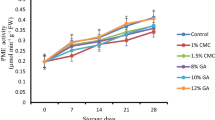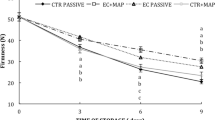Abstract
Jamun or Indian blackberry (Syzygium cumini L.) is a minor and highly perishable fruit enriched with flavonoids, essential oils, anthocyanins phenolic compounds and other antioxidants. The quantitative and qualitative losses in this seasonal fruit are tremendous and can be reduced by appropriate packaging and storage techniques which have not been applied hitherto. This study was undertaken to extend the shelf-life as well as to assess the biochemical, microbiological and physiological changes in jamun fruit under perforated and non-perforated modified atmosphere (MA) conditions. Fruits were stored under differential MA in macro-perforated (1 and 2 perforations, 0.3 mm dia. each) and non-perforated polypropylene (PP) film packages (Thickness: 35 μm, bag area: 0.036 m2) at 5 °C and 75% relative humidity (RH) for 23 days. Sachets containing white silica gel beads were placed inside all the packages to check water accumulation, if any. Different physiological, biochemical and microbiological characteristics which generally affect the post-harvest life of the produce were monitored during the storage period. Results of the study suggested most of the subjectively and objectively determined qualitative parameters to be retained satisfactorily under macro-perforated packaging treatments. Further, the microbiological analysis, surmised that the fruits could be stored for long term using packages with 1 macro-perforation.




Similar content being viewed by others
References
Al-Ati T, Hitchkiss JH (2003) The role of packaging film permselectivity in modified atmosphere packaging. J Agric Food Chem 51(14):4133–4138
Amanatidous A, Slump RA, Gorris LGM, Smid EJ (2000) High oxygen and high carbon dioxide modified atmospheres for shelf-life extension of minimally processed carrots. J Food Sci 65:61–66
Amiri A, Bompeix G (2004) Micro-wound detection on apple and pear fruit surfaces using sulphur dioxide. Postharvest Biol Technol 36:51–59
Babic I, Roy S, Watada E, Wergin WP (1996) Changes in microbial populations on fresh cut spinach. Int J Food Microbiol 31:107–119
Benherlal PS, Arumughan C (2007) Chemical composition and in vitro antioxidant studies on Syzygium cumini fruit. J Sci Food Agric 87:2560–2569
Bhargava UC, Westfall AB, Siehr DJ (1968) Prelimnary pharmacology of ellagic acid from juglens nigrra (black walnut). J Pharmaceutical Sci 57:1728–1732
Burton KS, Frost CE, Nichols R (1987) A combination of plastic permeable film system for controlling post harvest mushroom quality. Biotechnol Lett 9:529–534
Carvalho PT, Clemente E (2004) The influence of broccoli (Brassica oleracea var. italica) fill weight on postharvest quality. Ciência e. Tecnologia. Alimentos. Campinas 24:646–651
Chang CC, Yang MH, Wen HM, Chern JC (2002) Estimation of total flavonoid content in propolis by two complementary colorimetric methods. J Food Drug Analysis 10:178–182
Chau K, Talasila P (1994) Design of modified atmosphere packages for fresh fruits and vegetables. In: Singh R, Oliveria F (eds) Minimal processing of foods and process optimization. CRC Press, Boca Raton, FL, pp 407–416
Chaudhary P, Ray RC (2007) Fermentation of jamun (Syzgium cumini L.) fruits to form red wine. Asean Food J 14:15–23
Daniels JA, Krishhnamurthi R, Rizvi SSH (1985) Effects of carbon dioxide on microbial growth and food quality: A review. J Food Prot 48:532–537
De Ancos B, Gonzalez E, Cano MP (2000) Effect of high-pressure treatment on the carotenoid composition and the radical scavenging activity of persimmon fruit purees. J Agri Food Chem 48:3542–3548
Del Caro A, Piga A, Vacca V, Agabbio M (2004) Changes of flavonoids, Vitamin C and antioxidant capacity in minimally processed citrus segments and juices during storage. Food Chem 84:99–105
Deza MA, Araujo M, Garrido MJ (2003) Inactivation of Escherichia coli 0157:H7, Salmonella enteritidis and Listeria monocytogenes on the surface of tomatoes by neutral electrolyzed water. Lett Appl Microbial 37:482–487
Dixon RA, Paiva NL (1995) Stress-induced phenylpropanoid metabolism. The Plant Cell 7:1085–1097
Gil MI, Artes F, Tomas-Barberan FA (1996) Minimal processing and modified atmosphere packaging effects on pigments of pomegranate seeds. J Food Sci 61:161–164
Gil M, Gorny J, Kader A (1998) Response of ‘Fuji’ apples slices to ascorbic acid treatments and low-oxygen atmospheres. Hort Science 33(2):305–309
Grisebach H (1982) Biosynthesis of anthocyanins. In: Markakis P (ed) Anthocyanins as food colors. Academic Press, New York, pp 69–92
Hasan SM, Hossain MM, Faruque A, Mazumder MEH, Rana MS, Akter R, Alam MA (2008) Comparison of antioxidant potential of different fractions of commelina benghalensis Linn. Bang J Life Sci 20(2):9–16
Kader AA, Zagory D, Kerbel EL (1989) Modified atmosphere packaging of fruits and vegetables. Crit Rev Food Sci Nutr 28:1–30
Kang H, Saltveit ME (2002) Antioxidant capacity of lettuce leaf tissue increases after wounding. J Agric Food Chem 50:7536–7541
Kim D, Smith N, Lee C (1993) Apple cultivar variations in response to heat treatment and minimal processing. J Food Sci 58(5):1115–1118
Klein BP (1987) Nutritional consequences of minimal processing of fruits and vegetables. J Food Qual 10:795–798
Klein BP, Perry AK (1982) Ascorbic-acid and vitamin-A activity in selected vegetables from different geographical areas of the United States. J Food Sci 47(3):941–945
Lana MM, Tijskens LMM (2006) Effect of cutting and maturity on antioxidant activity of fresh-cut tomatoes. Food Chem 97(2):203–211
Loewus FA, Loewus MW (1987) Biosynthesis and metabolism of ascorbic acid in plants. Crit Rev Plant Sci 5:101–119
Lougheed EC (1987) Interactions of oxygen, carbon dioxide, temperature, and ethylene that may induce injuries in vegetables. Hort Sci 22:791–794
Luck E, Jager M (1997) Antimicrobial food additives, 2nd edn. Springer, New York
Matsukawa R, Dubinsky Z, Kishimoto E, Masak K, Masuda Y, Takeuchi T (1997) A comparison of screening methods for antioxidant activity in seaweeds. J Appl Phy 9:29–35
McDonald S, Prenzler PD, Antolovich M, Robards K (2001) Phenolic content and antioxidant activity of olive extracts. Food Chem 73:73–84
Nagata M, Yamashita I (1992) Simple method for simultaneous determination of chlorophyll and carotenoids in tomato fruit. J Japan Soc Food Sci Technol 39:925–928
Paull RE (1999) Effect of temperature and relative humidity on fresh commodity quality. Postharv Bio Technol 15:263–277
Rahman MAA, Moon SS (2007) Antioxidant polyphenol glycosides from the plant draba nemorosa. Bull Korean Chem Soc 28(5):827–831
Rai DR, Jha SN, Wanjari OD, Patil RT (2009) Chromatic changes in broccoli under modified atmospheres in perforated film packages. Food Sci Tech Int 15(4):0387–395
Reynertson KA, Yang H, Jiang B, Basile MJ, Kennelly MEJ (2008) Quantitative analysis of antiradical phenolic constituents from fourteen edible myrtaceae fruits. Food Chem 109(4):883–890
Rice-Evants CA, Miller NJ, Paganga G (1996) Structure-antioxidant activity relationships of flavonoids and phenolic acids. Free Radic Biol Med 20:933–956
Sharma SB, Nasir A, Prabhu KM, Murthy PS, Dev G (2003) Hypoglycaemic and hypolipidemic effect of ethanolic extract of seeds of Eugenia jambolana in alloxan-induced diabetic rabbits. J Ethnopharmacol 85(2–3):201–206
Singh S, Krishnamurthi S, Katyal SL (1967) Fruit Culture in India, ICAR, New Delhi, p 225
Swain T, Hillis WE (1959) The phenolic constituents of prunus domestica 1. The quantitative analysis of phenolic constituents. J Sci Food Agri 10:63–68
Tamura H, Yamagami A (1994) Antioxidative activity of monoacylated anthocyanins isolated from muscat bailey a grape. J Agri Food Chem 42:1612–1615
Tano K, Arul J, Doyon G, Castaigne F (1999) Atmospheric composition and quality of fresh mushrooms in modified atmosphere packages as affected by storage temperature abuse. J Food Sci 64:1073–1077
Timberlake CF, Henry BS (1988) Anthocyanins as natural food colourants, plant flavonoids in biology and medicine II: Biochemical, cellular and medicinal properties. Liss, New York, pp 107–121
Toivonen PMA (1997) The effects of storage temperature, storage duration, hydro-cooling, and micro-perforated wrap on shelf-life of broccoli (Brassica oleracea L., Italica Group). Postharvest Biol Technol 10:59–65
Tomkins RB, Cumming BA (1988) Effect of pre-packaging on asparagus quality after simulated transportation and marketing. Sci Horti 36:25–35
Author information
Authors and Affiliations
Corresponding author
Rights and permissions
About this article
Cite this article
Rai, D.R., Chadha, S., Kaur, M.P. et al. Biochemical, microbiological and physiological changes in Jamun (Syzyium cumini L.) kept for long term storage under modified atmosphere packaging. J Food Sci Technol 48, 357–365 (2011). https://doi.org/10.1007/s13197-011-0254-y
Revised:
Accepted:
Published:
Issue Date:
DOI: https://doi.org/10.1007/s13197-011-0254-y




